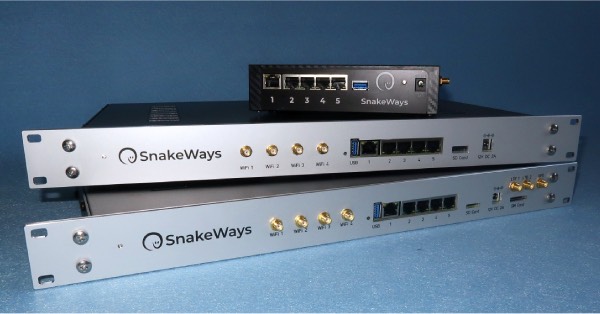When SnakeWays launched the original SnakeBox in 2021, it was heralded as the smallest, lightest, most cost-effective device of its kind on the market. Not simply an intelligent router with LTE built-in but an independent application host for shipboard email, firewalling, tracking and crew welfare services.
Two years on from that initial launch SnakeWays GmbH have added two new rack mounted versions of the original SnakeBox to their product portfolio. More than a standard SnakeBox in a bigger cage, SnakeWays say the SnakeBox X and the SnakeBox XL are a significant upgrade with both models incorporating the latest 64-bit technology and all new Wi-Fi 6 interfaces providing faster real world speeds and improved range to shipboard Wi-Fi networks.

“A number of our customers with sophisticated hybrid WAN solutions and multiple LAN installations on board were demanding more flexibility from the SnakeBox. They were also looking for a standard rack mounted version “, says Peter Schulze, CEO of SnakeWays. “In developing these two new products the SnakeWays team have taken the opportunity to improve upon the original SnakeBox and add some new features. Many of these improvements are behind the scenes but the most obvious one is the inclusion of 4 separate Wi-Fi 6 interfaces in both the SnakeBox X and the SnakeBox XL. The result is a total of 9 separately configurable LAN/WAN interfaces available, 10 when you include the in-built LTE interface of the SnakeBox XL”
Designed specifically for the maritime market where VSAT installations are being combined with LEO, LTE and L-Band solutions, SnakeWays say that the new SnakeBoxes bring a high degree of efficiency and performance. Particularly when bandwidth is restricted and high latency is the norm. Even where latency is not an issue, with LEO networks for example, SnakeWays states that the SnakeBox X and SnakeBox XL provide flexibility and enhanced performance with SD-WAN functionality, auto-switching and least cost routing.
“Auto -switching based on quota is already a popular feature used by a number of our VSAT customers“, says Schulze, “In addition both the new SnakeBoxes allow any specific shipboard LAN or device to be dedicated to a single WAN segment, whilst other services on board are free to “roam” to whatever WAN segment is available. For example, an IOT service on board can be permanently routed via Iridium since coverage and consistent connectivity are more important than bandwidth for that application. Simultaneously the ship’s email and crew internet can be routed via the VSAT, with automatic failover to that same Iridium. When combined with SnakeWall, our intelligent firewall service, the SnakeBox X and SnakeBox XL can also decide what services are available to crew over the backup WAN. The trend towards multi-WAN and multi-LAN configurations on today’s vessels demands that level of flexibility and control”

SnakeWays stated aim has always been to reduce implementation and support costs for their customers and that principle has been applied to development of the SnakeBox X and the SnakeBox XL. Both SnakeBoxes can be configured, monitored and controlled remotely via the SnakeCloud service. Direct remote access to the on-board equipment is provided through SnakeWays highly efficient SnakeDoor service which comes as standard with both new SnakeBoxes. The SnakeDoor service is designed specifically to offer remote access over networks where bandwidth may be very low and latency high.
“Frequently used over a vessels backup service” says Schulze “SnakeDoor enables many shipboard connectivity issues to be resolved remotely that otherwise would need a visit from an engineer, thus saving our customers and our distribution partners both time and money.”






































